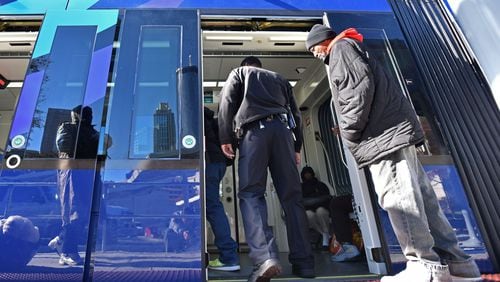Facts about streetcar rebirth
- At the turn of the last century, streetcars crisscrossed many American cities. By the 1960s, the automobile had usurped them. Streetcar tracks nationwide and in Atlanta were ripped out.
- As of early 2014, a dozen streetcar systems were operating nationwide, seven were under construction and 21 were in some stage of planning.
- The Atlanta Streetcar was originally imagined in 2005 as the Peachtree Streetcar, which would have run up and down Peachtree Street as it did in the early 20th century.
- By 2009, the concept for the streetcar had broadened so that it also ran east-to-west as it does today, connecting Centennial Olympic Park to the King Center and Historic Auburn Avenue District. In order to obtain the funding, the city was forced to trim the Peachtree leg from the final grant proposal.
- The Atlanta Streetcar was brought to life through a $47 million federal transportation grant awarded in 2010. The total cost of the system construction was $98 million.
With confetti, beaming public officials and picture-snapping crowds, the Atlanta Streetcar system opened a year ago after multiple delays. At the time, streetcar supporters — chief among them, Atlanta Mayor Kasim Reed — didn't know the year ahead would entail a revolving door of staffers, scathing safety audits, equipment failures and a barrage of criticism.
“This is a project that I believe will be a model for other cities across the United States of America,” Reed boasted at its opening ceremony on Dec. 30, 2014.
An Atlanta Journal-Constitution review of the streetcar’s inaugural year found that underlying many of its troubles was confusion over who was in charge of the $98 million system, as the city shared responsibility for its operation with MARTA. The AJC, through multiple open records requests, also found that streetcar boosters have overstated the system’s economic development impact, and that ridership has fallen short of early projections, despite the fact that the streetcar has been free all year.
City officials acknowledge a steep “learning curve” in their first year, but believe the streetcar is accomplishing its goal of revitalizing downtown neighborhoods.
“Generally, I think the streetcar has been a success,” said Melissa Mullinax, a senior adviser to Reed. “It’s done what we hoped it would do in terms of economic development and the knitting back together of two parts of downtown that were separated by the highway.”
The streetcar's success is critical because the city has ambitious plans to grow the system to include more than 50 miles of tracks. It will, officials say, help Atlanta compete on a world stage in the coming decades. But getting the needed federal grants will likely hinge on local taxpayers agreeing to shoulder up to half of the estimated $5 billion dollar price tag.
‘It wasn’t clear who was in charge’
Taking a ride on the streetcar’s 2.7-mile track is like stepping onto one of those moving walkways at the airport. It sits at street level, slowly meandering past offices and pedestrians.
Outside the windows are weedy lots and abandoned storefronts. There are also signs of progress: new attractions, high-rises with an influx of tenants, charming shops in restored old buildings and a swath of construction cranes.
Its riders are a mix of office workers, students, tourists, and on any given day, probably at least half a dozen homeless people.
Most have no inkling of the behind-the-scenes chaos that plagued much of the system’s first year.
The streetcar’s growing pains have been sharp for a city stepping into the unfamiliar role of transit operator. It was because of the city’s inexperience that it found itself handcuffed to MARTA at the outset, as federal authorities required the start-up to be overseen by a proven transit agency.
The partnership is where many of the problems originate, the AJC found.
“It wasn’t clear early on who was in charge,” said Mullinax, adding that the city is now trying to streamline what she described as a “top heavy” management structure.
Former Atlanta Deputy Chief Operating Officer Tom Weyandt described the pairing as a “forced marriage” that led to conflicts as the entities launched the system.
“That was lost time, it was lost energy,” said Weyandt, who retired in 2014.
An example of discord between the agencies came in a July internal audit that found flaws in the system’s safety practices and management.
The audit found that MARTA’s director of streetcar services (as well as the streetcar manager, an Atlanta hire) hadn’t read its system safety program. What’s more, the director “denied any active management responsibilities for the system,” in conflict with documents outlining his duties.
MARTA officials disagree with the findings, noting that the director of streetcar services has performed his job capably.
Rich Krisak, MARTA’s chief operating officer, said the authority has always been clear on its role.
“I think we did the best we could, given the circumstances and limitations we were given,” Krisak said.
Critical oversights
Meanwhile, the city struggled to hire transit experts after it decided in 2014 to run the streetcar in-house, instead of using an outside company to manage the project. Because of the boom in streetcar systems across the country, Mullinax said, many of the seasoned professionals had been gobbled up by other cities or private firms.
Nearly all of its top management has turned over in the past year alone. The absence of leadership resulted in critical oversights, not to mention the ire of federal authorities. Several drivers lacked required licensing. Service was suspended in July because of problems with the overhead electrical system. Safety checks went undocumented.
Manpower shortages made service unreliable, Krisak acknowledged, adding that the streetcar is now fully staffed on the operations side.
That inconsistency discouraged riders like Rebecca Burns, a former editor for Atlanta Magazine, who tried to take the streetcar to her office for six months.
Burns was on a first-name basis with the customer service employee. In those early days, he would often tell her, apologetically, that operators had not shown up or had called in sick. Often, she said, only one streetcar was operating.
“After a certain point, that was no longer excusable and it really just came down to management,” Burns said. “I wanted it to succeed, and it failed me when I was trying to cheer for it.”
In recent months, the city has sought to stabilize the system by hiring a private contractor through an emergency contract, which will remain until a permanent management structure is in place.
All because of the streetcar?
Despite well-known operational troubles, streetcar boosters say the system has been a catalyst for billions of dollars in downtown development.
A city of Atlanta press release issued on the streetcar’s opening day stated: “Before even opening, the Atlanta Streetcar attracted $561 million in investment between 2011 and 2014 within a five minute walk of the track alignment.”
That figure has grown to include just over 100 projects totaling upwards of $2.5 billion in investment that are either already built, under construction or in design, according to figures from the Atlanta Downtown Improvement District, which helped fund the streetcar.
But an AJC analysis revealed that some of the major projects touted as being drawn downtown by the streetcar were conceived of before the route was identified in 2008.
For example, Georgia State University’s $60 million renovation of the former SunTrust Bank building at 25 Park Place, and its $83 million College of Law, were in the University’s 2006 master plan.
Also on the list are the Georgia Aquarium’s $110 million AT&T Dolphin Exhibit, the $70 million National Center for Civil and Human Rights and the $67 million College Football Hall of Fame.
A spokesperson for the Georgia Aquarium said that the dolphin exhibit had been in the works since 2007. And the planners behind the Center for Civil and Human Rights had already selected its site in 2008, after being offered the land two years prior.
John Christie, interim president of the company that operates the College Football Hall of Fame, said while the streetcar wasn’t part of the group’s decision in 2009 to move to Atlanta, “it certainly didn’t hurt.”
A.J. Robinson, who heads the downtown improvement district, conceded that some of the developments built prior to construction of the streetcar may be questionable.
“Is this all because of the streetcar? No, but it’s within a five-minute walk of the streetcar, and so I think it had something to do with it,” Robinson said.
The link between most of the developments touted by the city and the streetcar is in reality “more coincidental than causal,” said Mike Dobbins, a professor in the Georgia Tech School of City and Regional Planning.
“I think it’s to be expected that a booster organization is going to grab up anything that can remotely be linked to what they’re boosting,” he said.
But Robert Puentes, a transportation policy expert with the Washington D.C.-based Brookings Institution, said his research shows transportation does drive development.
Indeed, many business owners told the AJC that the streetcar had either attracted them or benefited them.
Jay Clark, CEO of Southeast Capital Companies, said the streetcar drove his decision to build a proposed $50 million housing complex near Edgewood Avenue. Kim Seak, owner of Atlantic Seafood Market inside the Sweet Auburn Curb Market, said he’s seen business increase about 10 percent since the streetcar opened. The curb market even began opening on Sundays this past September because of the influx of new customers. And Octavian Stan, co-owner of Condesa Coffee, said he and his business partners moved to the Atlanta Daily World building to be close to the line.
“The fact that it was being built there definitely affected our decision,” Stan said.
The big test of 2016
Based on past performance, the streetcar is on track to end its first year with about 900,000 trips, short of earlier projections.
A MARTA consultant estimated in 2013 that ridership would reach 1.1 million trips in the first year if no fare was charged, and probably more since that figure only took into account weekday trips.
Robinson said that the downtown improvement district didn't have a firm ridership goal, and instead is judging the system on a variety of metrics, from operations to economic impact. He said his group and the city are "very pleased" with first year performance.
The AJC review also found the passenger counting system was not always reliable. Internal documents show the technology malfunctioned at various times, forcing the city to rely on manual counts and estimates.
Earlier this month, the city was seven months behind in reporting monthly passenger data to the federal government, according to the Federal Transit Administration. As a result, Atlanta risked becoming ineligible for future federal transit grants.
Mullinax said the city fell behind in reporting after the employee in charge of that left. Following AJC inquiries, she provided evidence that ridership data is now up to date. She also said the city was able to recapture the lost data and remains confident in the ridership figures.
The true test for the streetcar’s popularity will come in January, when Atlanta will begin charging riders $1 per ride.
MARTA estimates predict fewer people will ride if a fare is collected.
But Reed is optimistic that ridership will only improve.
“The streetcar is going to get stronger and stronger the further you get away from the growing pains,” he said.
Maya Roseberry, an East Point woman who recently rode with her daughter, isn’t sure she’ll pay.
“I could walk to my destination,” Roseberry said. “I could buy some candy with that dollar.”
Roxana Flammini and German Tagni were headed to the King Center when they boarded the streetcar on a recent weekday afternoon. The couple, from Buenos Aires, said they would have happily paid.
“It’s very easy to understand how to go around,” Flammini said. “I was thinking that in my city, it would be a good idea.”
About the Author






